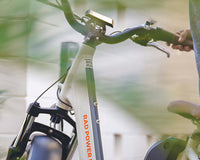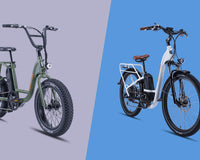There are three class types of electric bikes. We break down their differences, discuss which class are Rad Power Bikes, and why it matters.
Why Are There Different Ebike Classes?
Similar to motorcycles, electric bikes are classified into different categories based on their basic functionality. Let’s review the three ebike class types, based on a model ebike law that most U.S. states have adopted as the basis of their state regulatory system:
-
Class 1: Pedal-assist only; motor provides assistance all the way up to 20 mph.
- Class 2: Pedal-assist or throttle; motor provides assistance all the way up to 20 mph.
- Class 3: Pedal assist only; motor provides assistance all the way up to 28 mph.
Can ebikes go even faster? Technically, yes. However, Class 1 and 2 motors shut off at 20 mph, and Class 3 motors shut off at 28 mph. Any additional speed is gained by rider power alone, and/or decreasing elevation (riding downhill).
What Class Are Rad Power Bikes Ebikes?
Prior to 2024, Rad Power Bikes designed only Class 2 ebikes. In fact, beginning in 2007, the company was one of the first to pioneer the combination of a throttle and pedal assist. When designing a safe, reliable, and enjoyable transportation solution, Rad took into account multiple factors: federal and local laws, bike usage, technology, and rider experience. The result: Class 2 ebikes with a full 750 watts of power.
Rad’s lineup of class 3-capable ebikes, which include the Radster Trail, Radster Road, and RadWagon 5, are specifically engineered to safely achieve higher speeds, and give riders the option to ride in class 1 or class 2 settings if they would like to cap their speed at 20 mph.

Can Ebike Riding Be Illegal?
According to Chief Product Officer Redwood Stephens, the decision to design Class 2 and 3 isn’t a light one, and plays a factor into every bike Rad develops. First, Rad creates ebikes to be compliant under the CPSC (Consumer Product Safety Commission) regulations for safety requirements applicable to ebikes. Those regulations prescribe limits for motor power and the maximum speed that a bike can operate when powered solely by the motor.
Second, Rad Power Bikes are designed so our riders are comfortable that their ride is legal on most roads and bike paths, based on state laws. “We design our bikes to be safe, and compliant with the law,” confirms Stephens. In multiple states, ebikes with motors that provide assistance at or above 20 mph are not permitted on many types of bike-focused infrastructure. Riding beyond those state and local restrictions can go against traffic laws and regulations, and potentially require licensing and registration fees.
As a rider, it’s vital you check your local laws in the rare case a road or path is not yet following the model ebike laws that treat Class 2 ebike the same as a traditional bike. After all, what good is your bike if you can’t ride it?

About That Need for Speed
As Class 2 ebikes, Rad Power Bikes are engineered to not only perform well up to the 20 mph (the speed that the bike’s motor shuts off), but also accommodate additional speed that occurs when traveling downhill.
“To consistently travel safely at higher speeds, the bike frame, brakes, suspension systems, and more have to be engineered for that,” says Stephens. We asked Stephens if that was being done in the industry. “Not always. Higher speeds often requires engineering new parts from scratch,” explains Stephens, “but some brands are not upgrading critical systems that such speeds require.”
Rad’s lineup of class 3-capable ebikes, which include the Radster Trail, Radster Road, and RadWagon 5, are specifically engineered to safely achieve higher speeds, and give riders the option to ride in class 1 or class 2 settings if they would like to cap their speed at 20 mph.
Safety and Technology
For Rad, our choice to focus on building the best Class 2 and Class 3 ebikes comes down to providing ebikes that not only travel at safe speeds, but meet and beat rider expectations each and every day. Safety is paramount to ensuring bike trails and paths are accessible for everyone. Designing specifically within Class 2 and 3 standards ensures that we are meeting that endeavor.
At a Class 2 and 3 designation, Rad engineers strike that perfect balance between cost, quality, and safety - ensuring you get a safe ebike using quality parts; legal to ride in most places; and at a great price.
Back to the Good Stuff
Ready to feel the wind in your hair on your ebike? Awesome. Rad Power Bikes is motivated to give all riders a Rad grin. So as to keep the grins firmly in place, we design our bikes to be as safe as possible. For us, that means Class 2 and 3 ebikes. Discover the ebike laws in your state, and read our blog to learn more about ebike laws around the world. 
Please note, this article is not a definitive or absolute source for ebike laws in your area. It is not meant to provide legal advice. Ebike laws are always changing, so please check your local laws before riding to make sure you are riding legally and safely.






